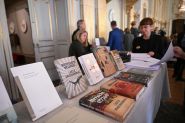
The "New Adult" genre is revolutionizing the book industry, driven by social media trends and vibrant, eye-catching covers. At the Frankfurt Book Fair, this popular literary movement, mixing romance with fantasy and darker themes, captivates a growing young readership.
In the sections dedicated to "New Adult" literature at the Frankfurt Book Fair in Germany, the flashy covers stand in stark contrast to the more subdued classics, a vital marketing approach for publishers of this rapidly growing genre. For the first time this week, the annual fair dedicated an entire hall to this literary movement, which has been boosted by social media, particularly through the hashtag "BookTok" on the short video platform TikTok.
"New Adult" literature, which comes in several subcategories such as "Romantasy" or "Dark Romance," has reignited a passion for reading in some, like Julia Kendall, a 30-year-old teacher browsing the colorful aisles of the hall. "For a while, I wasn't reading at all until I held my first Mona Kasten novel, which I loved!" she says, referring to a popular German author of “Romantasy,” which blends elements of romance and fantasy.
These authors have gained rock-star status, followed by legions of devoted fans willing to stand in line for hours for a meeting or an autograph. Among them is Jane S. Wonda, a successful author of "Dark Romance," which mixes traditional romance elements with erotica and darker themes like violence and drugs. Her works "break boundaries" and allow readers to free themselves from a society that is "too proper" to explore "morally grayer" areas, she explains to AFP at her booth.
"New Adult" literature targets a young audience and often includes explicit descriptions of sexual scenes or drug use. Close to her readers, Jane S. Wonda closely monitors their reactions, particularly on Instagram and TikTok, which influence her writing. "I’ve developed many of my stories with them," she says, standing in front of a shelf filled with books with black, silver, or pink covers.
A Changing Sector
Colorful patterns, gold accents, dyed edges… the appearance of books is crucial in this literary genre and requires significant investment from publishers. “For many young adult readers, a book is more than just a reading medium,” explains Jeannette Bauroth, head of the publishing house Second Chances, which translates books into German that were overlooked by other German publishers. Many of them want “pretty books” to take selfies in front of a nice bookshelf for their social media, she adds.
Commercial development also relies on e-books, which are shaking up the industry. “This generation naturally moves from analog to digital,” comments Karin Schmidt-Friderichs, president of the German Publishers and Booksellers Association, who speaks of a “reading fever” among young adults. Their buying habits are “changing the industry,” says Astrid Ohletz, who runs the independent publishing house Ylva, based in Germany and specializing in lesbian romance novels.
“The big publishers are conservative. They know they have to change, but they don’t really like it,” she adds. A former employee at a law firm, she founded her own company twelve years ago and primarily sells e-books in German and English in several countries. She criticizes parts of the genre, which she finds “misogynistic,” and the way romantic relationships are sometimes portrayed. “I wish some of these books were healthier,” she says. Nevertheless, she is pleased with the trend, which she believes is encouraging more and more young people to buy books.
With AFP



Comments